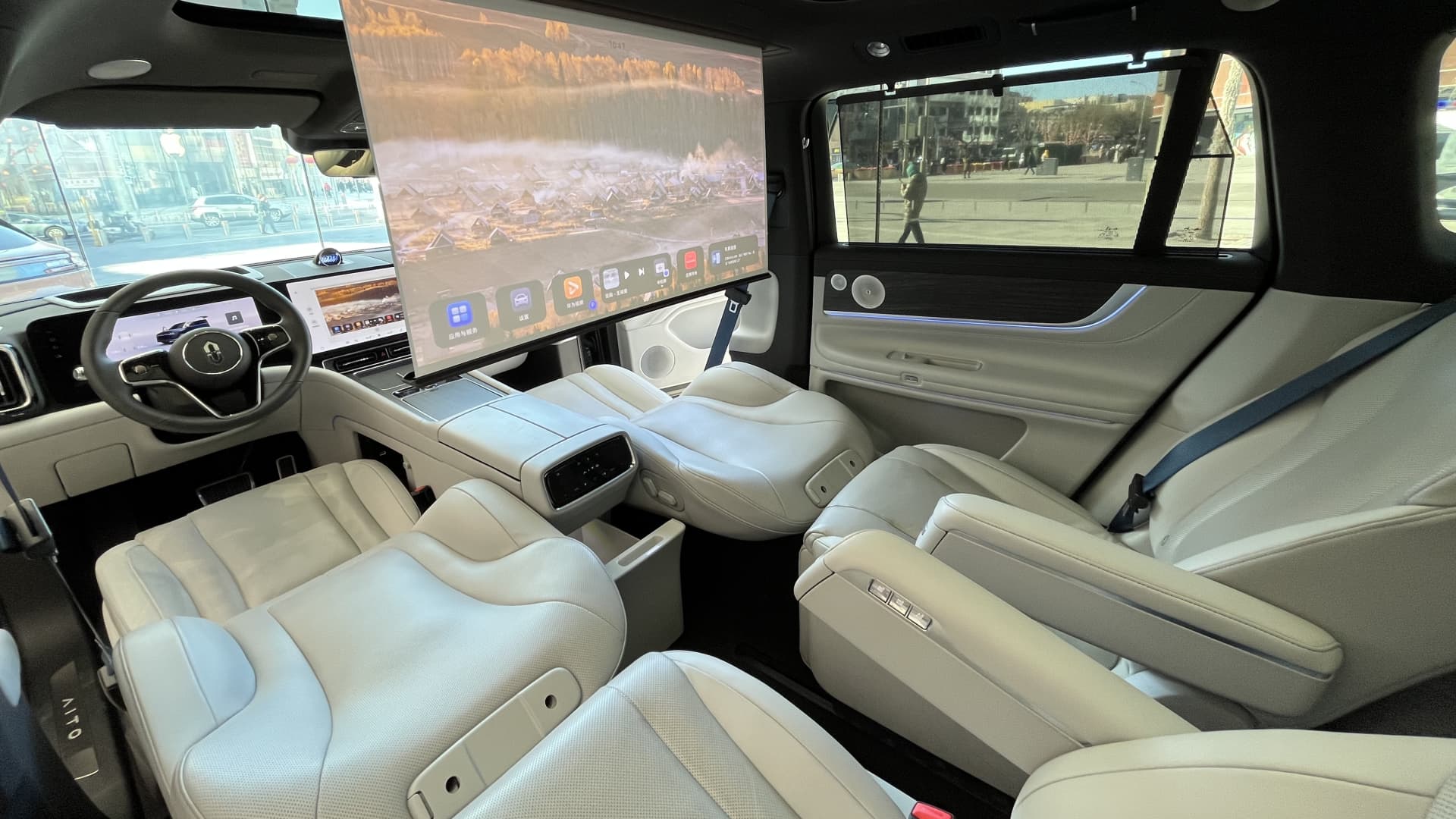The front seats of the Aito M9 SUV can be adjusted to create reclining chairs for the second row. Passengers can watch a movie on the roll-down projector screen while storing drinks in a refrigerator compartment.
CNBC | Evelyn Cheng
BEIJING — Hot competition in China’s electric car market is pushing local automakers to sell vehicles with fancy tech that Tesla doesn’t yet offer in the country — and sometimes at lower prices.
No longer are companies competing primarily on driving range. Instead, as they reveal new models at a rapid pace, they’re piling on a slew of features: in-car projectors, refrigerators and driver-assist, to name a few.
Tesla’s cars don’t come with those accessories, and Elon Musk’s automaker only offers a limited version of its driver-assist tech in China right now.
“Electric vehicles in China becomes a consumer electronics [product]. It’s similar to the cellphone industry,” said Li Yi, chairman and CEO of Appotronics, a Shenzhen-based laser display company that claims to work with major automakers.
“In China, I think it’s more entertain[ment], more gadgets, people really want to buy something with the most advanced tech specs,” he said, adding that in Europe, people focus more on functionality.
Appotronics claims it made the 32-inch projection screen that unfurls inside the newly launched M9 SUV from Huawei’s Aito brand. Huawei did not immediately respond to a request for comment.
As of Jan. 1, Aito said orders for the M9 surpassed 30,000 vehicles, with deliveries set to begin in late February.
The six-seater car comes with a refrigerator, collapsible front seats, and instead of a physical dashboard, tech that projects the information so it appears overlaid on the road ahead. This tech, known as AR HUD, can also display navigation instructions.
The M9 SUV sells for about 470,000 yuan to 570,000 yuan ($66,320 to $80,430).
In comparison, Tesla’s Model Y, a mid-sized SUV, starts at 258,900 yuan while the Model S sedan starts at 698,900 yuan.
Among other well-known competitors, Li Auto‘s L9 SUV starts at 429,900 yuan and comes with AR HUD, a refrigerator and driver-assist tech.
Xpeng‘s G9 SUV, widely considered a leader in China for driver-assist tech on city streets, starts at 289,900 yuan.
That’s just a peek at the swath of cars and the available bells-and-whistles in China. More than 100 new EV models are due to launch in 2024 in China, according to HSBC.
Consumers’ interest in new car models has focused on in-vehicle tech features and driver-assist capabilities — “far more advanced” than prior electric cars or traditional gasoline-powered vehicles, said Yiming Wang, analyst at China Renaissance Securities.
Price and maximizing mileage are two other top considerations for consumers, Wang said.
A multi-million dollar business
Appotronics’ Li expects that demand for car tech will help his new business segment generate “a few hundred million” yuan this year in revenue – the equivalent of about $40 million to $100 million, he said. The Shanghai-listed company previously made about $300 million in overall revenue a year, Li said.
When asked about Tesla, Li said he wasn’t authorized to disclose details but said people at the U.S. automaker “want something completely different than Chinese carmakers.”
He also noted that in Appotronics’ experience, Chinese customers are willing to pay a premium for car tech, while U.S. automakers are more focused on reducing costs.
That’s because electric car batteries and other parts aren’t made in the U.S., which means American companies are already paying a premium for core components of the electric car, Li said.
Chinese companies dominate the supply chain for electric car batteries.
In fact, the main reason why BYD has succeeded is because of its early work in batteries, where it can now reduce costs, pointed out Zhong Shi, an analyst with the China Automobile Dealers Association.
BYD surpassed Tesla by total car production in 2023, and sold more battery-only cars than the U.S. automaker did in the fourth quarter.
Traditional foreign auto giants like Volkswagen are struggle to adjust to the surge of electric cars in China, while domestic companies, including smartphone company Xiaomi and Geely-backed startup Zeekr, are rushing to release electric cars.
“I think the German system is coming from the mechanical, the bottom-up. [The] Chinese system is coming digital, top-down,” observed Omer Ganiyusufoglu, a member of German’s National Academy of Science and Engineering.
When designing a car, German engineers think about horsepower first, while Chinese engineers start with the cockpit design and then the interior, he said, citing a Chinese car engineer, when he spoke Monday at a Huawei event on “5G Advanced.”
China’s driver-assist push
Driver-assist has emerged in the last year as competitive feature for electric cars in China.
Tesla’s version for helping with driving on highways — called Autopilot — is available in the country, but the company’s “Full Self Driving” (FSD) feature for city streets is not.
Chinese regulators are gradually allowing passenger cars to use more driver-assist features in cities, such as for smooth braking at traffic lights. Chinese authorities in November also announced a nationwide push for developing driver-assist and self-driving technologies via pilot programs.
However, it remains unclear to what extent consumers are willing to pay for such features.
“Even though customers, specially those in China, always indicate in surveys that they are willing to pay for general safety and navigation [advanced driver assistance system] features, their answers change when they are asked about specific ADAS features and their buying behavior tells are different story,” said Shay Natarajan, a partner at Mobility Impact Partners, a private equity fund that invests in transportation.
“There are over 20 unique ADAS features,” she said, noting blind spot warnings or surround camera view were the most popular items. “Note that FSD is not on top of the list of ADAS features customers are willing to pay for.”


